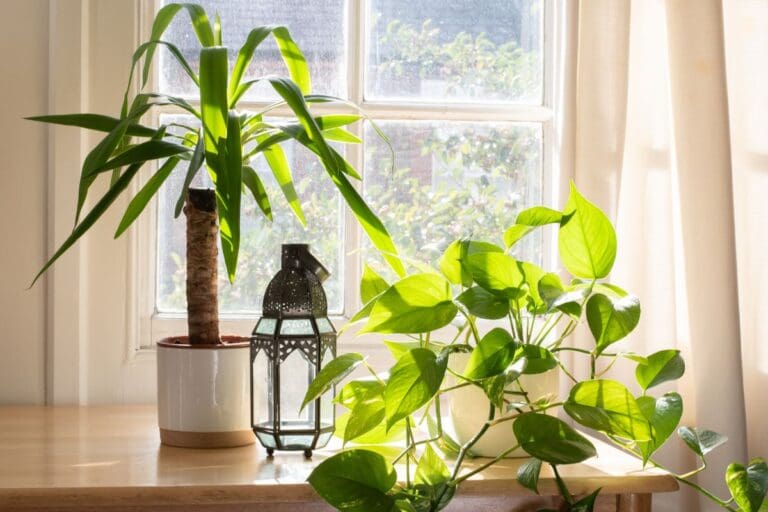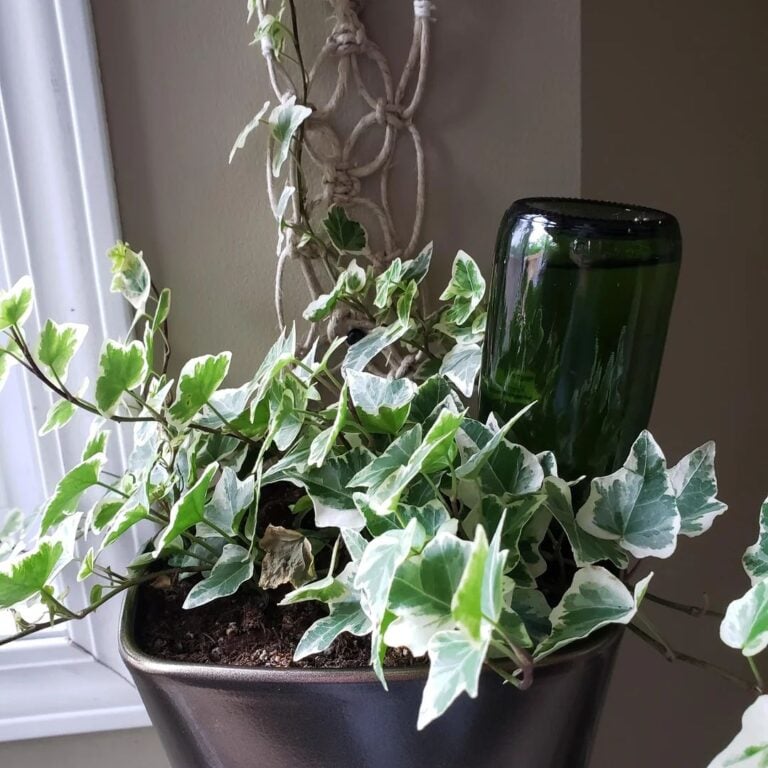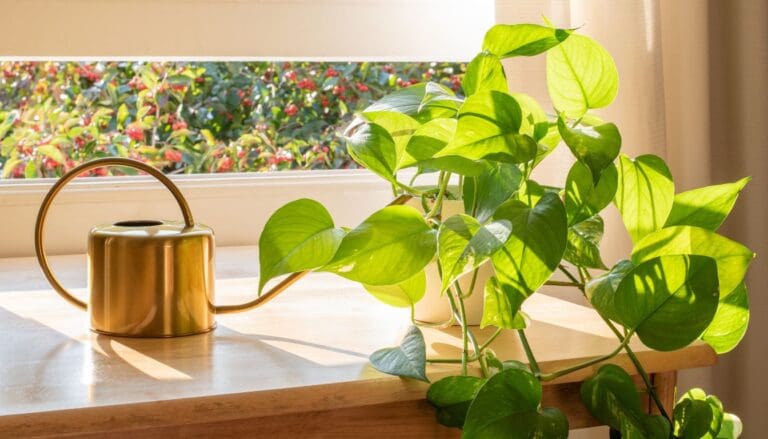String of Turtles Plant Care Guide: Easy Tips for Thriving Plants
Are you ready to take your indoor plant game to the next level? 🌿 Meet the String of Turtles—an adorable, low-maintenance plant that’s perfect for any home. This little gem, also known as Peperomia prostrata, has round, turtle-shell-like leaves that make it a standout choice for plant lovers.
Taking care of these cuties is easier than you might think.
To keep your String of Turtles thriving, make sure to water them sparingly and provide bright, indirect light.
It’s a semi-succulent, which means it can store water in its leaves, so overwatering is a big no-no! Too much water can lead to root rot, and nobody wants that.
Got a sunny window? Your String of Turtles will be happy!
If conditions are just right, you might even see some daisy-like flowers blooming. 🌼
Don’t forget to share your plant journey in the comments below.
What’s your favorite spot for your indoor garden? Let’s chat! 🪴

Please note: Simplify Plants is reader-supported. As an Amazon Associate, I earn from qualifying purchases made by our readers with no extra cost added to you all! Some links in the post are affiliate links and I get a commission from purchases made through links in the post.
Getting Started with Turtle Plant Care
Caring for a String of Turtles plant can be a delightful journey. This delicate plant requires attention to specific details like choosing the right species and gathering essential supplies.
Choosing the Right Species
When picking a String of Turtles, also known as Peperomia prostrata, it’s important to choose healthy ones. Look for vibrant green leaves with distinct patterns that resemble a turtle’s shell.
Avoid plants with yellowing leaves or spots, as these could indicate health problems.
It’s best to get your plant from a reputable nursery or plant store.
Make sure you select a plant that fits well in your indoor environment and suits your aesthetic preferences.
Does your home get a lot of natural light? 🌞 If yes, this plant will be a lovely addition!
Essential Supplies
Once you’ve chosen your plant, it’s time to gather the supplies.
You’ll need a small pot with drainage holes, a good quality regular potting mix, and a watering can.
I recommend getting a spray bottle for misting as these plants enjoy occasional humidity.
Trim with clean and sharp scissors if you plan to propagate the plant later.
Don’t forget to place the pot near a window where it can get indirect sunlight. 🌤️ Too much direct sun can scorch the leaves, so be careful!
Got any favorite tips for taking care of your turtle plant? Share them in the comments! 🐢🌿
Ideal Indoor Environment

Creating the perfect indoor environment for your String of Turtles involves getting the lighting, temperature, and humidity just right. Here’s what you need to know to keep your plant thriving.
Lighting Requirements
For my String of Turtles, bright, indirect light works best. A spot near a north or east-facing window usually does the trick.
Direct sunlight can be too harsh and might scorch those little leaves. 🤭 So, be sure to avoid placing the plant right under intense sunrays.
I sometimes use sheer curtains to diffuse the light.
If you don’t have suitable natural light, artificial grow lights are a great alternative.
Fluorescent or LED lights should do well, just ensure they provide the right spectrum for plant growth.
How do you know if your String of Turtles is happy?
If the leaves are vibrant and plump, you’re nailing the lighting conditions. If they look dull or sparse, it might need a bit more light.
Have you tried different spots in your home for your plant? 🌞
Temperature and Humidity Control
My String of Turtles thrives in typical indoor temperatures between 65-85°F (18-29°C). It’s pretty flexible but hates the cold.
Ensure the room doesn’t drop below 55°F (13°C). 🥶 No one likes being cold, not even plants!
As for humidity, this plant enjoys moderate humidity.
Regular household humidity levels are fine, but in drier conditions, consider using a humidifier or placing the pot on a tray with water and pebbles. Just don’t let the pot sit directly in the water.
Do you find the air in your home too dry?
Keep an eye on those leaves to see if they start to shrivel. A little extra humidity might do the trick.
Are you planning to try a humidifier or some other method to keep your plant comfy? 🌿
Planting and Repotting

When it comes to planting and repotting your string of turtles, ensuring the right soil mix and techniques can make all the difference. Let’s dive into the best practices for keeping your plant happy and healthy 🐢🏡.
Soil Selection
To thrive, my string of turtles needs a well-draining soil mix. I like to use a regular potting mix combined with some perlite or sand. This helps prevent root rot by improving drainage.
Using a mix designed for succulents or cacti can also work great. Finding the right balance is key—moist but not soggy.
Another tip is adding a bit of orchid bark to the mix, which promotes air circulation around the roots. This is especially useful in indoor environments.
Have you tried different soil mixes? Feel free to share what works best for you 🌱.
Potting and Repotting Techniques
When it’s time to plant or repot my string of turtles, I start by choosing a pot with drainage holes. This is crucial to avoid waterlogging, which can lead to root systems drowning.
For new cuttings, I’ll gently snip off 3-inch segments just below a node and remove the lower leaves.
I fill the pot with my preferred soil mix and place the cuttings directly into the soil, ensuring the node is buried.
For established plants, repotting every 2-3 years helps refresh the soil and allow for growth. Make sure the plant isn’t root-bound before repotting, as this can stress it out.
Do you have any repotting tips or tricks? Drop a comment below and let’s keep our turtle strings thriving together! 🌿✂️
Watering Routine

Maintaining the proper watering routine for a String of Turtles plant is essential for its health. Too much or too little water can harm the plant, so timing and observation are key.
Watering Schedule
I water my String of Turtles about once a week. This plant loves moisture, but it’s also semi-succulent, meaning it stores water in its leaves. 🪴
It’s smart to allow the top 1/4 to 1/2 of the soil to dry out before I water it again.
Using a pot with a drainage hole is crucial because it prevents water from getting trapped in the soil and causing root rot.
I always make sure to water thoroughly, letting the water escape through the bottom.
Sometimes, a bit of dried soil on top can be misleading, so always check below the surface! 🌿
Signs of Overwatering or Underwatering
Detecting whether I’m overwatering or underwatering is pretty straightforward.
If the leaves look yellow and mushy, that’s a clear sign of overwatering. In contrast, if they appear shriveled or wrinkled, it indicates underwatering.
I often touch the soil to feel its moisture level. Another check is lifting the pot; if it feels unusually heavyweight, it might be too wet inside.
Drooping leaves are a weaker sign of underwatering and should prompt me to adjust my routine.
Dropping a comment below if you’ve found other handy tips—let’s learn from each other’s plant care victories! 🌱
Nutrition and Fertilization

When it comes to keeping our string of turtles plants happy, providing the right nutrients and fertilization is key 🌿. Let’s talk about what types of fertilizer work best and how often to feed these cute little plants.
Fertilizer Types
For string of turtles, I usually recommend succulent fertilizers. These come in two main forms: slow-release pellets and liquid fertilizers.
- Slow-release pellets: These are great if you prefer a hands-off approach.
- Liquid fertilizers: Ideal for those who like to have more control over feeding.
I find that a balanced fertilizer with an N-P-K ratio of 20-20-20 also works well.
Keep the potting mix slightly moist but not soggy when you fertilize to prevent root burn. Sometimes, I mix the liquid fertilizer at half strength to avoid overfeeding.
Feeding Frequency
Now, how often should we be feeding our string of turtles?
I usually go with feeding once every 4-6 weeks during the growing season (spring and summer).
During the dormant period (fall and winter), I cut back on feeding to maybe once every 2-3 months.
Over-fertilizing can be harmful, causing root burn or leaf yellowing. 🐢 So, it’s important to stick to a proper schedule.
Are you consistent with your plant’s feeding routine? Share your experience with me in the comments! Let’s help each other grow the best string of turtles 🌱.
Do you prefer slow-release pellets or liquid fertilizers? Let me know your go-to choice and why!
Pruning and Maintenance

Keeping your String of Turtles plant healthy involves regular pruning and cleanup. This will help your plant thrive and keep it looking neat. Let’s dive into the details!
Pruning Techniques
Pruning your String of Turtles is pretty simple. ✂️
First, make sure you sanitize your tools. Clean, sharp scissors or pruning shears work best.
I always use rubbing alcohol or a bleach solution to wipe the blades before cutting.
Next, snip off stems just below a node. This encourages new growth and keeps the plant looking tidy.
Aim for cuttings that are about 3 inches long. You can even use these cuttings to propagate new plants. 🌱
Removing dead or yellow leaves is also a must. These can drain energy from the plant. Focus on cutting stems evenly to promote balanced growth.
Regular Cleanup Tips
Keeping your String of Turtles clean is key to preventing disease.
One simple trick I use is to dust the leaves gently with a soft cloth or brush. This removes any dirt or pests that can harm the plant.
Check for dead leaves daily. It only takes a minute! Removing these helps avoid decay and keeps the plant in top shape.
Also, inspect the soil occasionally. If you see any fungus or mold, it’s time to refresh the potting mix.
Finally, rotate your plant every week to ensure even light distribution. This helps all parts of the plant grow evenly. 🌞
Maintaining this routine will ensure your String of Turtles stays vibrant and healthy.
Who else has tried these tips? Share your experiences in the comments below! 🌿❤️
Pest Prevention and Control

Dealing with pests can be a real headache for indoor plant lovers like us. Luckily, there are effective ways to keep those pesky invaders away from our beloved String of Turtles.
Common Pests
While String of Turtles is generally resistant to pests, they can occasionally attract some unwanted visitors.
The most common pests that might bother this plant include mealybugs and spider mites.
Mealybugs are tiny, white, cotton-like insects that hide in leaf joints.
Spider mites are even smaller and can cause the leaves to look speckled and unhealthy.
To spot infestations early, check the undersides of leaves and stems regularly.
Keep an eye out for any webbing or sticky residue.
Early detection can save a lot of trouble later on!
Natural Remedies
If you do find pests, don’t worry! There are gentle ways to handle the situation without harsh chemicals.
A simple method is to use a soapy water solution.
Mix a few drops of mild dish soap with water and spray it on the affected areas.
Another option is to use neem oil, which works wonders against most pests.
Also, consider introducing beneficial insects like ladybugs into your indoor garden – they love to munch on pests!
Have you tried these methods before? Let me know in the comments! 🌱✨
Keeping our plants happy and healthy is all about regular care and attention. Let’s share our tips and tricks for pest-free plants! What’s your go-to method for dealing with pests?
Propagation Methods
When it comes to propagating String of Turtles, it’s all about using stem cuttings or leaves, and providing the right care to ensure new plantlets thrive.
I’ll walk you through the process and show you the best methods to grow more of these charming plants at home. 🌱
Step-by-Step Propagation
First, grab a sterile pair of scissors.
Cut a section of the stem right below a node (where leaves and roots meet the stem). Make sure the cutting is around two inches long.
Next, remove a few leaves from the base to expose the nodes.
If you want to speed up the rooting process, dip the cut end into rooting hormone.
It’s not necessary but highly recommended!
Plant the cutting into a pot with moistened soil.
A soil mix with good drainage works best — think cactus or succulent mix.
You can also use a humidity dome to keep the environment moist for better root growth.
Care for New Plantlets
Once you’ve done the initial setup, place the newly planted cuttings in a spot with bright, indirect light.
Direct sunlight can be too harsh on the delicate cuttings.
Keep the soil lightly moist but be careful not to overwater.
Overwatering can lead to root rot, which is a big no-no for String of Turtles.
In a few weeks, you should start seeing new roots forming. 🎉
Don’t forget to check on your plantlets regularly and give them all the love and attention they need to grow strong and healthy.
Have you tried propagating plants before? Share your tips and experiences in the comments below! 🌿💬
Troubleshooting Common Issues
Taking care of a string of turtles plant can be pretty smooth, but sometimes you run into a few bumps. Here, I’ll go through some of the common problems you might face and how to fix them fast.
Yellowing Leaves
Nobody likes to see yellow leaves on their plants! This often means overwatering. 🌧️
The string of turtles is semi-succulent, so it doesn’t need as much water as other plants.
Make sure the soil dries out between waterings. A quick tip is to stick your finger in the soil about an inch deep; if it’s dry, it’s time to water.
Yellow leaves might also be due to insufficient light.
These plants love bright, indirect light. Try placing your plant near a window where it can get plenty of natural light.
Remember, too much direct sunlight can scorch the leaves. If you notice yellowing along with mushy stems, it’s more likely an issue with water and not light.
Stunted Growth
Is your string of turtles not growing as fast as you’d like? This can be due to a few reasons.
One major cause is lack of nutrients. 🥀
These plants benefit from a balanced fertilizer once a month during the growing season. Make sure not to over-fertilize, as this can damage the roots.
Temperature and humidity can also affect growth.
If your home is too cold, growth might slow down. Aim for a comfortable range between 65-85°F (18-29°C). 🌡️
For humidity, keep it moderate. If you live in a dry area, a small humidifier or regular misting can do wonders.
So, is your string of turtles thriving or facing some problems? Let me know in the comments, and feel free to share your own tips! 🌱 💚
Seasonal Care
Maintaining a String of Turtles plant requires attention to changes in the seasons. Adjust your care techniques for winter and summer to keep your plant thriving all year round.
Winter Care Guide
Winter can be tough for String of Turtles. It’s crucial to adjust watering habits during this season.
The plant needs less water in winter because it grows slower. I water mine less frequently, only when the soil is completely dry. Overwatering can cause root rot, a real plant killer.
Winter also brings lower light and shorter days.
Place your plant in the brightest spot available. If natural light is limited, consider a grow light to keep your plant happy. 🌿
Temperature is another factor.
String of Turtles prefers temperatures between 65-85°F (18-29°C) and can suffer in cold drafts or near windows where it might get too cold. Keep it away from these areas.
Also, humidity levels can drop in winter due to indoor heating.
I like to mist my plant occasionally or use a humidity tray to keep the air slightly moist. How do you keep your plants cozy in winter? Share in the comments! 😊
Summer Adjustments
Summer means more light and warmth, which String of Turtles love! But with great sun comes the need for greater care.
I move my plant to a spot with bright but indirect light. Direct sunlight can scorch the leaves, so a filtered light is best.
In summer, this plant needs more water due to faster growth.
I check the soil regularly and water when the top inch feels dry. Just be cautious of overwatering, especially if it’s humid. During this time, maintaining a routine can help your plant flourish.
High temperatures can also be a challenge.
Keep an eye on your plant if it’s near a window or outside, and remember, while String of Turtles likes warmth, it doesn’t enjoy extreme heat.
Using a fan or moving the plant to a cooler spot might be necessary during heatwaves. Do you have any summer tips? Let’s discuss below! ☀️
Frequently Asked Questions
Do String of Turtles need a lot of light?
Nope! They prefer bright, indirect light. Put them near a window with lots of sunlight, but not directly in the sun. Too much sunlight can be harmful.
How often should I water my String of Turtles?
Water it only when the top inch of soil is dry. I always stick my finger in the soil to check. 💧 Overwatering is a common mistake, so be cautious.
Can I propagate my String of Turtles?
Yes, you can! Cut off a trailing piece and place it in soil. Make sure your cutting is at least 3 inches long. Propagation is super easy and fun. Just snip, plant, and wait!
Do String of Turtles flower?
Surprisingly, they do! If their growing conditions are just right, you might see little daisy-like flowers. They bloom in small clusters and are quite a sight.
What’s the best temperature for String of Turtles?
They thrive in the same temperature range we do, between 65-85°F (18-29°C). Just avoid letting the temperature drop below 55°F (13°C).
Should I use special soil for my String of Turtles?
Not necessarily. A regular potting mix works fine. Just make sure it’s moist but not soggy. Too much water can cause root rot.
Can I place my plant outdoors?
It’s best to keep them indoors unless you live in a mild climate. They can be sensitive to direct sunlight and extreme temperatures. 🌞
Why are my String of Turtles’ leaves turning yellow?
Yellow leaves usually mean too much water or not enough light. Check your watering routine and light exposure. Keep an eye out and adjust as needed.
Conclusion
Taking care of a String of Turtles plant can be a fun and rewarding experience. These plants are not only adorable but also relatively easy to care for. 🌿
Provide bright, filtered light for the best growth. If you’re short on natural light, grow lights work too.
Just keep them about 6 to 12 inches above your plant for 12 to 14 hours a day.
Water when the soil is slightly dry, but avoid letting it get soggy. Overwatering can lead to root rot, which no one wants. 💧
A pot with drainage holes is a must!
Average household temperature and humidity are just fine. If you’re comfy, your plant is likely comfy too.
Keep the temperature between 65-85°F.
Propagate your String of Turtles easily by snipping off a few cuttings and placing them in moist soil.
Before you know it, you’ll have more plants to share with friends or fill up your home!
Have you tried growing a String of Turtles? I’d love to hear about your experiences! 🌱
Share your thoughts and tips in the comments below!
Remember, plant care should be enjoyable. So, have fun and watch your String of Turtles thrive! 🐢
Note: Some images in the articles are sourced from Reddit and Other Platforms For Reference Purpose.







